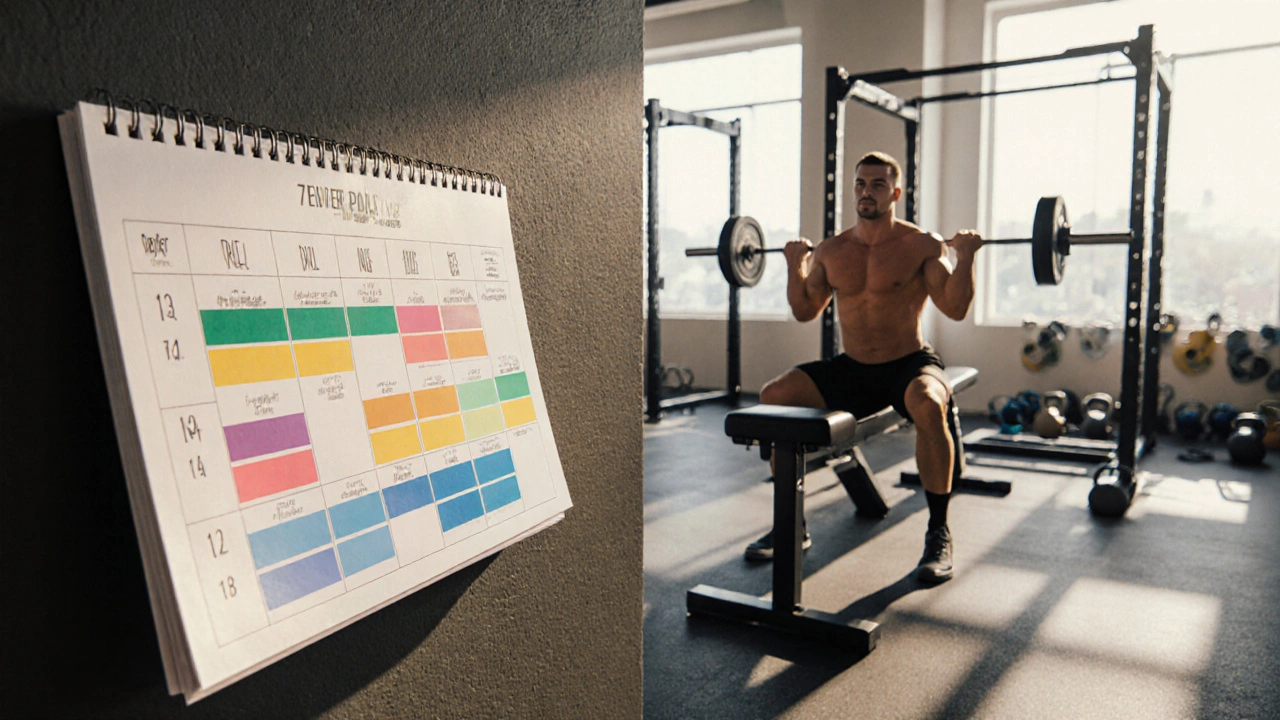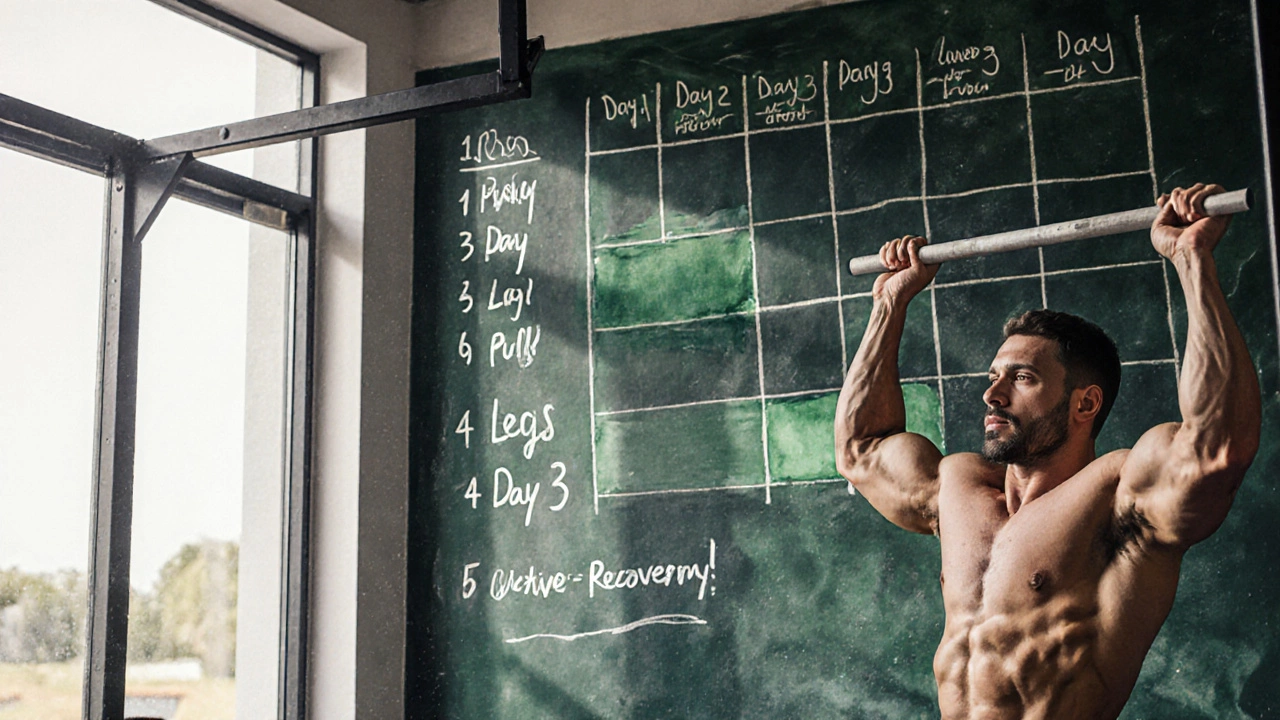Is Lifting 5 Days in a Row Too Much? Pros, Cons & Safe Strategies
 Oct, 26 2025
Oct, 26 2025
5-Day Lifting Split Generator
Get a personalized 5-day training schedule that maximizes gains while respecting recovery needs. This tool helps you structure your routine based on your experience level, goals, and equipment availability.
Wondering whether a five‑day‑a‑week lifting schedule is a recipe for gains or a shortcut to burnout? The answer isn’t a simple yes or no-it depends on how you manage volume, intensity, and recovery. Below you’ll find a clear breakdown of the science behind frequent training, practical program ideas, and warning signs to keep you moving forward without hitting a wall.
Key Takeaways
- Five days of lifting can work if you balance load, vary muscle groups, and prioritize recovery.
- Watch for signs of overtraining such as persistent fatigue, sleep disturbances, and stalled strength.
- Use split routines, deload weeks, and proper nutrition to mitigate risk.
- Always tailor frequency to your experience level, lifestyle, and goals.
Understanding Training Frequency is the number of workout sessions you perform within a set time frame, usually a week
When it comes to strength training, frequency is one of the three core variables alongside intensity (how heavy you lift) and volume (total reps × sets). Research shows that increasing frequency-while keeping total weekly volume constant-can improve motor‑unit recruitment and protein synthesis spikes, especially for intermediate lifters. However, more sessions also mean more stress on the nervous system and connective tissue, so the balance is crucial.
How the Body Recovers
After each lift, muscle fibers experience microscopic damage. The repair process-driven by muscle protein synthesis-creates new contractile proteins, making the muscle stronger. This process peaks roughly 24‑48 hours post‑workout and then tapers off. If you train the same muscles again before synthesis drops, you risk incomplete repair, which can lead to chronic fatigue and injury.
Recovery isn’t just about the gym. Sleep quality, carbohydrate‑rich meals, and adequate protein (≈1.6‑2.2 g per kg body weight) are non‑negotiable. Hormones like cortisol rise with stress, and elevated levels over several days suppress protein synthesis and impair sleep. Managing these factors is what our next section focuses on.

Risks of Too Much Frequency
Training five days straight can tip into Overtraining Syndrome if you ignore warning signs. Common symptoms include:
- Persistent muscle soreness lasting more than 72 hours
- Decreased performance despite consistent effort
- Elevated resting heart rate and poor sleep
- Mood swings, irritability, or loss of motivation
Beyond performance drops, chronic overtraining can weaken the immune system, raise injury risk, and even affect hormonal balance, leading to decreased testosterone and increased estrogen in men.
When a 5‑Day Routine Can Actually Work
If you structure the week so that each muscle group gets sufficient rest, five sessions become a strategic advantage. Here’s how:
- Split Routine: Divide the body into focused sections (e.g., push, pull, legs, upper, lower) so no single muscle is hit on consecutive days.
- Vary Intensity: Alternate heavy, low‑rep days with lighter, higher‑rep sessions to reduce neurological fatigue.
- Include Mobility & Light Recovery Work: Use one day for active recovery-foam rolling, mobility drills, or low‑intensity cardio-to promote blood flow without adding mechanical stress.
For beginners, a three‑day full‑body plan is usually safer. Intermediate lifters often find a four‑day upper/lower split works well, while advanced athletes may adopt a five‑day “push-pull-legs‑upper‑lower” schedule.

Sample 5‑Day Split
- Day 1 - Push (Chest, Shoulders, Triceps): Bench press 4×6, Overhead press 3×8, Dips 3×10.
- Day 2 - Pull (Back, Biceps): Deadlift 3×5, Pull‑ups 4×8, Barbell rows 3×10.
- Day 3 - Legs (Quads, Hamstrings, Glutes): Squat 4×6, Romanian deadlift 3×8, Leg press 3×12.
- Day 4 - Upper Body Hypertrophy: Incline dumbbell press 3×12, Cable rows 3×12, Lateral raises 3×15.
- Day 5 - Lower Body Power: Front squat 3×5, Box jumps 4×6, Calf raises 4×15.
Notice the deliberate spacing-push and pull are separated by a leg day, giving the shoulders and back at least 48 hours of rest. Weeks ending with a power‑focused lower‑body session also let the central nervous system recover before the next training block.
Frequency Comparison Table
| Program | Days per Week | Typical Split | Recovery Focus | Best For |
|---|---|---|---|---|
| 3‑Day Full‑Body | 3 | Full‑body each session | High‑intensity each day, full rest days | Beginners, limited time |
| 4‑Day Upper/Lower | 4 | Upper / Lower alternating | Moderate volume, 48‑hr muscle rest | Intermediate lifters |
| 5‑Day Push‑Pull‑Legs‑Upper‑Lower | 5 | Push, Pull, Legs, Upper Hypertrophy, Lower Power | Strategic muscle rotation, active recovery day | Advanced athletes seeking higher weekly volume |
Tips to Avoid Overtraining on a 5‑Day Schedule
- Prioritize Sleep: Aim for 7‑9 hours; quality matters more than quantity.
- Eat for Recovery: Include 20‑30 g of high‑quality protein within two hours post‑workout and maintain a slight caloric surplus if muscle gain is the goal.
- Schedule Deload Weeks: Every 4‑6 weeks, reduce weight by 40‑60 % or cut volume in half to let the nervous system reset.
- Track Fatigue: Use a simple 1‑10 scale after each session; if scores consistently exceed 7, consider dialing back intensity.
- Incorporate Mobility: Spend 10‑15 minutes on dynamic stretches or yoga to keep joints healthy.
By weaving these habits into your routine, you keep the hormone balance right, support protein synthesis, and give your muscles the downtime they need to grow.
Can beginners safely train five days a week?
Generally no. Beginners benefit more from 3‑day full‑body sessions that allow ample recovery and mastery of basic lifts. If a novice insists on five days, they should keep intensity low, focus on technique, and include several active‑recovery or mobility days.
What’s the biggest red flag that I’m overtraining?
A persistent drop in strength or performance despite consistent effort, coupled with poor sleep and mood changes, is the clearest indicator. Monitoring resting heart rate first thing in the morning can also reveal hidden stress.
How should I structure my nutrition on a 5‑day plan?
Consume 1.6‑2.2 g of protein per kilogram of body weight daily, spread over 3‑4 meals. Carbohydrates should be higher around training sessions (30‑50 g per hour of work) to replenish glycogen, while healthy fats support hormone production.
Is a deload week enough to prevent injuries?
Deloads are essential, but they work best alongside daily recovery practices-adequate sleep, proper mobility work, and balanced nutrition. Skipping these day‑to‑day habits can still lead to injuries even with a scheduled deload.
Should I include cardio on my 5‑day lifting schedule?
Light to moderate cardio (20‑30 minutes) on recovery or mobility days can improve blood flow and aid muscle repair. Keep intensity low to avoid adding extra stress that could interfere with strength gains.
Bottom line: lifting 5 days in a row isn’t inherently bad, but success hinges on smart programming, vigilant recovery, and listening to your body. Adopt a split that respects muscle rest, fuel the process, and cycle in deload weeks-then you’ll reap the strength benefits without the burnout.
